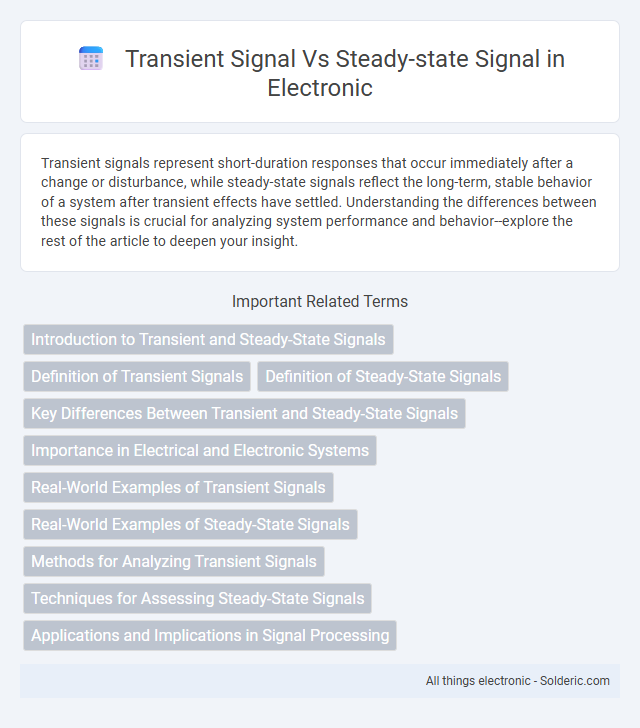Transient signals represent short-duration responses that occur immediately after a change or disturbance, while steady-state signals reflect the long-term, stable behavior of a system after transient effects have settled. Understanding the differences between these signals is crucial for analyzing system performance and behavior--explore the rest of the article to deepen your insight.
Comparison Table
| Aspect | Transient Signal | Steady-State Signal |
|---|---|---|
| Definition | Temporary signal appearing during system transitions | Constant signal after system stabilization |
| Duration | Short-lived, brief | Long-lasting, continuous |
| Cause | Sudden changes in input or system state | Equilibrium condition of system |
| Behavior | Rapid change, non-periodic | Periodic or constant amplitude |
| Importance in analysis | Indicates system response and stability | Represents normal operating conditions |
| Examples | Switching signals, impulse response | Sinusoidal waves, DC voltage |
Introduction to Transient and Steady-State Signals
Transient signals represent short-duration waveforms that occur during system changes or disturbances, characterized by rapid variations and non-periodic behavior. Steady-state signals display consistent, periodic patterns with constant amplitude and frequency, indicating system stabilization after transient effects subside. Analyzing transient and steady-state signals is crucial for understanding system dynamics, stability, and response in electrical engineering and signal processing applications.
Definition of Transient Signals
Transient signals are temporary, non-repetitive waveforms that occur during the transition between two steady states in a system, often characterized by rapid changes or spikes in amplitude. These signals typically arise from sudden disturbances, system startup, switching events, or faults and last only for a short duration before settling into a steady-state signal. Understanding transient signals is crucial for analyzing system stability, designing filters, and ensuring your equipment handles unexpected surges without damage.
Definition of Steady-State Signals
Steady-state signals are continuous signals that maintain consistent amplitude, frequency, and phase over time, representing stable system behavior after initial transients dissipate. These signals are crucial in analyzing long-term system performance and equilibrium conditions. In contrast to transient signals that exhibit temporary changes, steady-state signals reflect the system's stabilized response in fields such as electrical engineering, control systems, and signal processing.
Key Differences Between Transient and Steady-State Signals
Transient signals exhibit temporary behavior characterized by rapid changes and occur immediately following a disturbance or system input, while steady-state signals maintain consistent amplitude and frequency over time after these initial variations settle. Transient responses contain higher frequency components due to sudden shifts, in contrast to steady-state signals which are dominated by fundamental frequencies and harmonics. Understanding these differences is crucial for signal processing, control systems, and circuit analysis to accurately predict system behavior and performance.
Importance in Electrical and Electronic Systems
Transient signals represent short-term, non-repetitive disturbances that occur during sudden changes in electrical systems, critically impacting device performance and reliability. Steady-state signals, characterized by consistent and predictable waveforms, allow for stable operation and accurate analysis of circuit behavior over time. Understanding both signal types is essential for designing robust electrical and electronic systems that maintain functionality and protect your components under varying conditions.
Real-World Examples of Transient Signals
Transient signals occur in real-world scenarios such as electrical surges during lightning strikes, the initial voltage spike when switching on electronic devices, and the sudden acceleration in mechanical systems like car engines starting. These signals are characterized by their short duration and rapid change in amplitude, differing significantly from steady-state signals, which maintain constant amplitude and frequency over time. Understanding transient signals is crucial for designing protective circuits and ensuring stability in power systems and electronic devices.
Real-World Examples of Steady-State Signals
Steady-state signals are characterized by constant amplitude and frequency over time, commonly found in real-world applications such as AC power supply waves and radio broadcast transmissions. These signals maintain stability and predictability, enabling devices like oscilloscopes and communication systems to analyze and utilize them effectively. Understanding steady-state signals helps you optimize system performance in electronics and signal processing applications.
Methods for Analyzing Transient Signals
Analyzing transient signals involves techniques such as time-domain analysis, which captures signal behavior over short periods, and frequency-domain methods like the Short-Time Fourier Transform (STFT) that reveal time-varying spectral content. Wavelet transforms provide a powerful tool for resolving both time and frequency characteristics of transient events, offering better localization than traditional Fourier analysis. If you need to understand rapid changes in systems or signals, employing these methods can enhance the accuracy and effectiveness of your signal processing tasks.
Techniques for Assessing Steady-State Signals
Techniques for assessing steady-state signals include frequency domain analysis, where tools like the Fourier Transform decompose signals into their constituent frequencies, enabling precise measurement of amplitude and phase characteristics. Time-domain methods such as averaging and filtering reduce noise and highlight steady-state behavior, facilitating accurate parameter extraction. Instrumentation like spectrum analyzers and lock-in amplifiers enhance signal detection and characterization under steady-state conditions by isolating relevant frequency components.
Applications and Implications in Signal Processing
Transient signals play a crucial role in systems where sudden changes or non-periodic events need detection, such as fault diagnosis in electrical circuits and seismic event monitoring. Steady-state signals, characterized by consistent periodic patterns, are essential in communications and control systems for reliable and continuous performance analysis. Understanding the distinction between transient and steady-state signals enables your signal processing applications to optimize data filtering, improve system stability, and enhance anomaly detection accuracy.
Transient signal vs steady-state signal Infographic

 solderic.com
solderic.com